“The I.D.E.A. District
is the single most significant economic development initiative in San Diego.
I’m personally committed to making it happen.”
MARK CAFFERTY,
CEO San Diego Regional
Economic Development
Corporation
The Race for Talent
Cities are competing in the most important race of the 21st Century: the race for talent. We define talent as the highly educated, highly mobile 24-35 year-olds that urban economist Joe Cortright has dubbed the “Young & Restless”. As Cortright explained at a recent presentation hosted by the San Diego Regional Economic Development Corporation and Equinox Center, a city’s ability to develop, attract, and retain these highly sought after young people is, by far, the biggest factor in driving future prosperity.1
College-educated, often with Masters Degrees, these young adults are tomorrow’s workforce and entrepreneurs. For any region that aspires to grow an innovation economy — one populated by companies that can thrive on the edge of disruptive technologies — they are the essential ingredients.
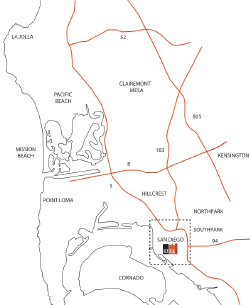
What is true for the future health of cities is equally true for the viability of businesses. Ask any CEO of our local knowledge-driven companies what is the single most important factor to sustaining a competitive edge? You will consistently get the same answer: attracting and retaining the best and the brightest.
Which leads us to a key question. What are they seeking?
The answer is largely shaped by generational shifts in two key values. First, this group is not simply taking the “best” job wherever it might be; rather, since they represent a scarce commodity that is often in high demand, they are targeting where they want to live as a key ingredient in their job selection criteria. Smart companies are aware of this trend and increasingly find that they need to locate where they have the greatest chance of landing the best talent.
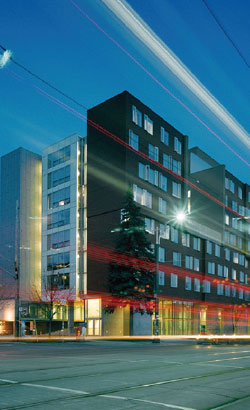
“Building places that anchor talent is the economic strategy for the 21st century.”
Next, by an increasing margin, this group of talented young people is choosing to live in urban settings versus suburbs. This finding should come as no surprise since every urbanist from Richard Florida2 to Edward Glaeser3 concurs that cities are where the real action will be in the 21st Century.
Based on Cortright’s research, we now have good insight into what specific qualities of an urban environment are most appealing to this cohort. They are:
- Ethnic and economic diversity
- Rich in amenities, including retail, restaurants, and cultural offerings
- Walkable
- Bikeable
- Good public transit
- Mix of housing types
Young people are selecting urban settings that offer unique experiences – very different from the generic suburbs in which many of them were raised.
The success of cities that understand this dynamic — Austin, Portland, Denver, San Francisco—and the corresponding high propensity of talented young people who choose these vibrant places, demonstrates how critical it is to build a downtown that attracts and retains them.
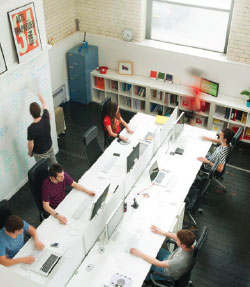
The current reality for San Diego is that in spite of our great weather and wonderful lifestyle, we are not among the top choices with this demographic when it comes to deciding where they want to settle4. According to Equinox Center research, San Diego had zero mentions in the top ten of most desirable cities to live in nine surveys done over the past two years with recent college graduates.
What we have yet to deliver is that unique mix of jobs, public spaces, cultural amenities, transportation, parks, and creative work environments to go along with the recent rapid pace of new downtown housing. In the race for talent San Diego has to work harder at growing an urban environment that has it all or we are going to have a difficult time maintaining, much less growing, the jobs and prosperity of our region.
“Compared with previous generations, today’s younger techies are less interested in owning cars and big houses. They prefer to live in central locations, where they can rent an apartment and use transit or walk or bike to work, and where there are plenty of nearby options for socializing during non-work hours.”
The I.D.E.A. District’s Response to This Challenge
The I.D.E.A. District is designed to bring jobs back downtown and grow a new jobs cluster that thrives because it speaks to the sensibilities of an emerging workforce. It’s a 21st century vision that utilizes the attributes that make our city potentially great – walkability, close proximity to transit, an international airport 10 minutes away, restaurants, culture, entertainment and a beautified bay front – and enhances them by adding clean, high-paying jobs.
This vision for an urban mixed-use district is driven by the innovation occurring at the intersection of design and technology. The concept has caught the imagination and attention of San Diego business and community leaders. It is rare that an economic development initiative has so many diverse constituencies rallied behind it, which is what makes it so promising.
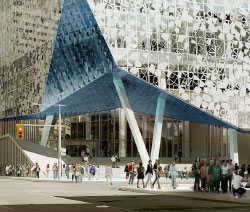
Academic research and case studies demonstrate the benefits of this clustering effect. The comprehensive 2009 study, “Clusters, Convergence, and Economic Performance,” illustrates this power. “Industries participating in a strong cluster register higher employment growth as well as higher growth of wages, number of establishments, and patenting…importantly, we find evidence that new industries emerge where there is a strong cluster environment.”5
What do we mean by a design and technology jobs cluster (which we designate in this document as design+technology)? We are referring to multiple disciplines that complement and accelerate technological advances – including product design, industrial design, advanced engineering, medical wireless, infographics, biomimetic design, graphic design, video gaming, 2-D to 3-D animation, media and post production. And those disciplines that increasingly use technology to innovate around architecture and landscape design, furniture design and more – that choose to co-locate in a specific area because it enhances their growth potential.
We need to look no further than the Torrey Pines Mesa to see the dramatic and positive impacts of co-location on the fortunes of the bioengineering industry. In “Building the Innovation Nation: The San Diego Experience”, the authors highlight this co-location phenomenon as it relates to the explosion of San Diego’s biotechnology and telecommunication industries over the last two decades. They point out that thirty years ago, San Diego was mostly known for its defense contractors and military presence. The article cites UCSD as the catalyst for a new transformation—by attracting scientists and engineers (intellectual capital), a business/industry/entrepreneurial network evolved creating mutually beneficial relationships. The cluster effect was quickly realized because, “Business leaders from innovative companies told us that they liked to locate their companies near world-class research institutions.”6
As this example illustrates, San Diego is now known as a science and technology town. So why propose a downtown cluster that focuses on design and technology? Steve Jobs, arguably the most influential force in the marriage of these two forces said, “Design is the fundamental soul of a man-made creation.” What he understood, and his company Apple has proven again and again, is that breakout companies, products and services in the 21st century will occur at the intersection of great design and technology.
Design touches and leverages every industry in San Diego, particularly technology. By creating a setting where the two can interact and placing it in the physical location where this workforce is inclined to locate, we can develop our design muscle to the same strength as our current technological prowess. This puts San Diego in a unique position to accelerate job growth, enhance the local economy and to continue to remain competitive.
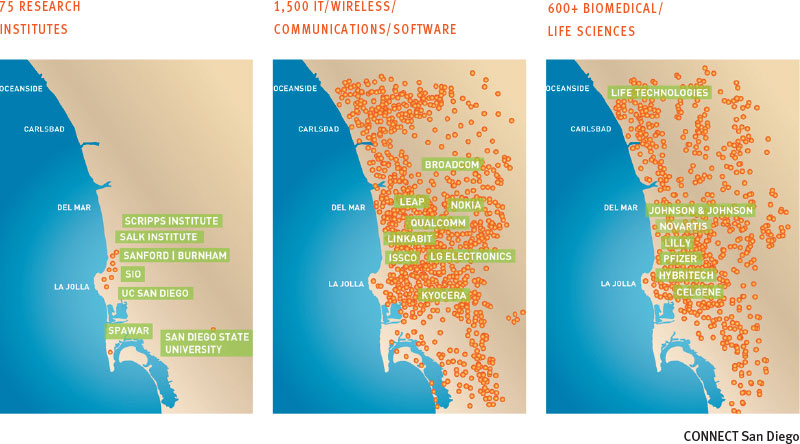
The rest of the world has clearly awakened to this phenomenon. In Spain, Barcelona’s 22@ has integrated economic, physical, and social regeneration with investment in economic and social programs and property development to create 56,000 jobs and thousands of new companies since 2000.7
South of Market (SOMA) in San Francisco has become the most prolific innovation district in the world with 5000 start-ups currently in the pipeline.8
And London’s Tech District, located in a formerly blighted part of East London, has produced thousands of new jobs during Europe’s recent severe economic downturn.
The Effect of Job Clusters and Co-location
As stated in the overview, the concept of “clusters” has proven extremely successful in positioning San Diego as a national leader in the telecommunications and biomedical industries. In evaluating the role of “clusters” on economic performance, researchers Mercedes Delgado, Michael Porter and Scott Stern observed that industries participating in strong clusters register higher employment growth as well as higher growth of wages, number of establishments, and patenting. Importantly, they found that new industries emerge where there is a strong cluster environment.1
A great deal of the current thinking on job clusters suggests that the most successful regions will not only grow new clusters, they also understand how to facilitate collaboration between clusters. That is why a design+technology jobs cluster is a perfect complement to San Diego’s already strong technology base. Many technology companies have products that showcase cutting-edge science, but they also require equally brilliant design to become commercially viable.
Co-location
Co-location is the natural outgrowth of the presence of strong job clusters. Examples of co- location range from car manufacturing in Detroit to the financial sector in New York to the software campuses of Silicon Valley to the film and entertainment industries of Los Angeles. Whether it is the presence of one catalyst firm driving supply chain demand or the participation of multiple firms benefiting from the shared resources of anchor institutions (like the New York Stock Exchange on New York’s financial industry), case studies show that clustering and co- location of similar businesses create an ecology of collaboration and innovation; one where the whole is much greater than the sum of its parts.
Existing Clusters in San Diego
75 RESEARCH INSTITUTES
1,500 IT/WIRELESS/COMMUNICATIONS/SOFTWARE
600+ BIOMEDICAL/LIFE SCIENCES
Check out this article from Atlantic Cities, July 19, 2012.
Endnotes
1. Delgado, Mercedes, Porter, Michael E. and Stern, Scott, Clusters, Convergence, and Economic Performance (October 1, 2010). US Census Bureau Center for Economic Studies Paper No. CES-WP-10-34. Available at SSRN: http://ssrn.com/abstract=1695011
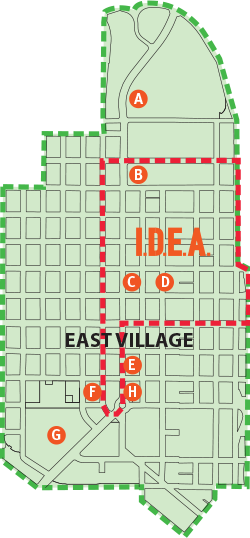
A San Diego High School
B San Diego City College
C NewSchool of Architecture & Design
D East Village Green
E Thomas Jefferson School of Law
F FIDM
G Petco Park
H New Central Library
The I.D.E.A. District is bounded on the north by City College/C Street, east by I-5, south by Market and west by 11th Street.
From Concept to Reality
The I.D.E.A. District possesses a combination of physical factors that make it ripe for reinvention – nearby transit, small walkable blocks, older underutilized buildings, planned public spaces, and land available for development. Perhaps most importantly, full entitlements with appropriate zoning and density are already in place.
Some of the area is still blighted, but this infill neighborhood (comprised of approximately 95 acres on 38 city blocks) in downtown San Diego’s Upper East Village already has key institutional anchors that will help accelerate and facilitate transformation. These include multiple schools and universities: The NewSchool of Architecture and Design (NSAD), Thomas Jefferson School of Law, San Diego City College and High School, and The Fashion Institute of Design and Merchandising. The stunning New Central Library, which will also house a charter high school, is certain to become one of the city’s most valued community spaces. Major civic and recreational amenities including Petco Park, the Convention Center, and Balboa Park are all within easy walking distance.
Our goal is to utilize these assets to establish a vibrant innovation ecosystem. One that leverages a rich social environment with thoughtfully designed spaces for living, working, playing, and learning. We believe, and the evidence supports, that fashioning a place and a culture that maximizes collisions between diverse, talented people will facilitate serendipity and foster the collaborations that spark new businesses.9
If we can accomplish this, we will become the favored location for companies that trade in ideas. That is why our real mission for I.D.E.A. District is to create an environment that grows more ideas per square foot.
By attracting a diverse cross section including designers, scientists, engineers, students, artists, and architects, I.D.E.A. District will become a model for:
- inspiring new projects by finding low-cost methods to quickly prototype ideas;
- encouraging adaptive reuse and sustainable practices;
- providing a wide array of housing and mobility options;
- most significantly, establishing employment opportunities in a physical and social setting desired by a talented work force.
What Turns the I.D.E.A. District from Intriguing Concept to Reality?
The migration of technology downtown has started to take hold with 170,000 square feet leased in the last 18 months,10 but the single most significant catalyst will be the move of a major design+technology company into the District. Once a highly respected company takes a significant chunk of creative office space, many satellite businesses will follow. Ultimately, the area will thrive when there is a combination of small, medium, and large companies; but to change the perception of the District from blighted to emerging, a visionary corporate leader is required.
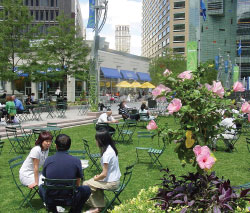
A second essential element is the programming of the city-owned park block between 13th and 14th, F and G Streets. We have dubbed this initiative as “Liberating the Park”. If accomplished it will allow this currently abandoned block to become a outdoor laboratory for showcasing the potential of what the park can become by using music, art, design, local artisans, even organic farming to explore programming and engage the public. Everything will be temporary, since the block will become part of the East Village Green. However, this formative period will invite experimentation to discover which activities are most valued by the community.
Innovation Takes Innovative Partners
To develop new districts today, a new form of partnership is required, so we have created the I.D.E.A. Collaborative. Major institutional partners have joined forces to address and solve significant urban problems. The first initiative: develop a solution to design, build, and program the East Village Green Park over a shared parking garage. This civic engagement partnership includes students, faculty, and practicing professionals from San Diego’s major educational institutions.
NewSchool of Architecture and Design – San Diego City College – San Diego State University (Schools of Engineering and Arts) – USD’s Burnham-Moores Graduate School of Real Estate – Thomas Jefferson School of Law – The San Diego Foundation
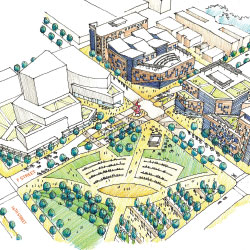
The Case for Urgency
This is not an opportunity that will last indefinitely. Development pressures are already building to turn one of the District’s best assets, available land, into five-story apartments over a parking podium. If this occurs it will forever preclude the potential for East Village to achieve something truly special and transformative. Imagine if, as some suggested at the time, we had decided to pass on UCSD and build more housing instead. Consider how that one strategic choice changed our region.
The potential economic impacts of the I.D.E.A. District are significant. The 38 city blocks have entitlements in place to build over three million square feet of office/studio space, 2,500 residential units, 340,000 sq. ft. of retail space and 300 hotel rooms, and this is not even the maximum allowable density. This amount of new space would translate into over 13,000 jobs, 4,000 residents, and nearly $21 million of new revenue annually to the city.
So, the challenge is before us. The undeniable convergence of technology and design, the presence of available urban land with great “bones”, and a strengthening economy all conspire to present us with a huge opportunity. Can all the stakeholders in this District work together to achieve a dynamic, jobs-rich mixed-use neighborhood that can produce extraordinary benefits for all? We are convinced that we can.
Once the momentum starts to build, there are a number of additional key projects that can shape the future of the District including:
- A new creative office building that provides an opportunity for San Diego-based design+technology firms to co-locate and collaborate; this building could also house a dedicated space for a new design+technology incubator;
- A space for creative-focused businesses, new to San Diego, that are recruited to become anchors for this new cluster. Examples would be IDEO (leading industrial designer) in Palo Alto or Activision (leader in video gaming) in Santa Monica;
- An “ARTS Blok”—a full city block containing a museum showcasing the works of major collectors with galleries and cafes at street-level, low-cost studio space a level above, and several hundred units of affordable artist housing on the upper floors;
- A flexible “watering hole” community space that provides for a lively discourse and exchange of ideas, trends, and issues and has a nocturnal life as a hip performance and visual arts space;
- A variety of well-designed and programmed public gathering spaces, including the East Village Green that facilitates interaction and relaxation among district inhabitants;
- Multiple retail and dining options, including a fresh market, all with a strong design/artistic influence, with outdoor cafes spilling onto the streets;
- Housing in a wide variety of forms and price points including student and artist housing and new models of supportive housing for the homeless;
- Bike and car-share programs encouraging residents and visitors to walk, bike, or use transit in the district.
Endnotes
- Presentation to the San Diego Economic Development Corporation and Equinox Center, September 14, 2011 ↩
- http://en.wikipedia.org/wiki/Richard_Florida ↩
- http://en.wikipedia.org/wiki/Edward_Glaeser ↩
- Equinox Center, “Best Cities in America for Young Adults”, National Survey Criteria and Analysis ↩
- Delgado, Mercedes, Porter, Michael E. and Stern, Scott, Clusters, Convergence, and Economic Performance (October 1, 2010). US Census Bureau Center for Economic Studies Paper No. CES-WP- 10-34. Available at SSRN: http://ssrn.com/abstract=1695011 ↩
- Walshok, Mary L., et al. “Building Regional Innovation Capacity: The San Diego Experience.” Industry and Higher Education. February 2002: 27-42. ↩
- Leon, Nick. “Attract and Connect: The 22@Barcelona innovation district and the internationalization of Barcelona business.” Innovation: management, policy & practice (2008). 10: 235-246. ↩
- Delevett, Peter, “Silicon Valley Finds its Heart In San Francisco”, San Jose Mercury News, August 7, 2012 ↩
- Johnson, Steven, Where Good Ideas Come From ↩
- Hughes, Jason, Hughes Marino San Diego Office Update Quarter 3 2012, October 17, 2012 ↩